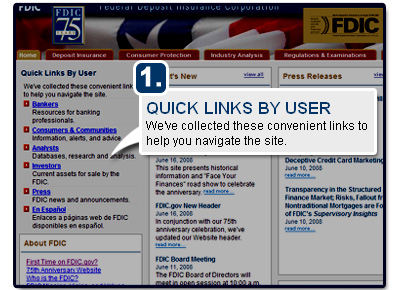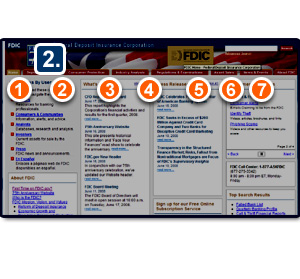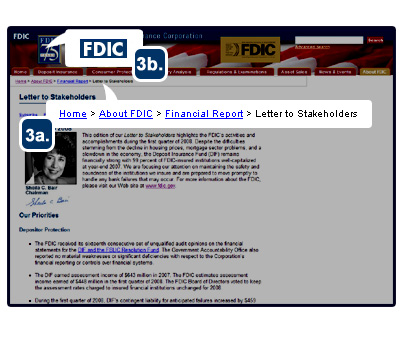
|
Help – First Time Users and Frequently Asked Questions
The FDIC Web Site provides many tools to assist you in locating and printing information on the site:
- Quick Links by User
- Information Categories
- Short Cuts
- Breadcrumb Trails
- FDIC Logo—Home Page Link
- Search
- SiteMap
- Contact Us or Provide Feedback
- Frequently Asked Questions
- File Formats
- Printing
- Accessibility
 1. Quick Links by User 1. Quick Links by User
Quick Links, located on the left side of the home page, list the most popular materials categorized by "types of users" of the FDIC's web site. These links are customized to meet the needs of each group. These listings are not all-inclusive. If you cannot locate a resource on a Quick Links page, you should try the site's main navigation or the search.
These pages, revised in March 2007, are designed for the following users:
 2. Information Categories 2. Information Categories
The main navigation at the top of each page consists of seven categories:
-
Deposit Insurance - Information on insured institutions, deposit insurance coverage of individual accounts, and the deposit insurance premium system.
-
Consumer Protection - Resources to educate and protect consumers, revitalize communities, and promote compliance with the Community Reinvestment Act and fair lending laws.
-
Industry Analysis - Financial information on specific banks as well as analyses of the banking industry and economic trends.
-
Regulation & Examinations - Information on banking laws and regulations and applicable policies and procedures used by the FDIC in examining financial institutions.
-
Asset Sales - Information concerning loans, real estate, and other assets for sale by the FDIC in its role as receiver for failed institutions.
-
News & Events - FDIC announcements and a schedule of FDIC-sponsored events.
-
About FDIC - Explanations of who the FDIC is and what we do, as well as the corporation's plans and reports, current job openings and business opportunities with the FDIC.
3. Shortcuts
 a. Breadcrumb Trails
a. Breadcrumb Trails
Many of the pages in the site contain breadcrumb trails.
The trail shows where the product lives inside the site's information architecture and contains live links to the higher level pages. The breadcrumb trail gives you one-click access to each of the pages it lists.
b. FDIC Logo—Home Page Link
The FDIC logo at the top left corner of each page is a link to the site's home page. A Home link is also contained in a list of links at the bottom of each page.
4. Search
Full Text Search - This page
enables users to search the text of all materials for specific
user-defined terms and phrases. The quick search box located at the top of each page on the site
provides the same search capability.
An Advanced Search with several more options for focusing your search is
linked from "Full Text Search" and from the search results
pages.
5. SiteMap
The SiteMap lists every product on the website both in alphabetic order and by the information category in which the product lives.
6. Contact Us or Provide Feedback
Contact Us gives names, addresses, phone numbers and e-mail addresses, listed both by topic and by official's title. This section of the website also provides related information like Access to Washington, DC, Facilities; Delays in Mail Delivery; and links to Other Government Financial Agencies.
Please provide your feedback on www.fdic.gov to webmaster@fdic.gov.
Every FDIC.GOV page provides a mailto link to the official responsible for that page. By clicking on that link, you open a pre-addressed form that will be e-mailed to that official.
7. Frequently Asked Questions
Some commonly asked questions regarding www.fdic.gov:
What does the FDIC do?
The Federal Deposit Insurance Corporation (FDIC) preserves and promotes public confidence in the U.S. financial system by insuring deposits in banks and thrift institutions for up to $100,000; by identifying, monitoring and addressing risks to the deposit insurance funds; and by limiting the effect on the economy and the financial system when a bank or thrift institution fails.
To find out more, go to "
Who is the FDIC?"
Where can I go to find out information about my bank?
The FDIC has a couple of ways to find information about your bank. Using the FDIC's Institution Directory (ID), you can get information on FDIC-insured banks. The ID contains information for all institutions, bank holding companies and bank offices or branches. Bank, branch, and web addresses are available in addition to regulator and financial information. Please note that if you are looking for a specific bank location, it may be a "branch" of the bank, not the bank itself.
The ID also has a "Compare to Peer Group" feature that allows users to compare insured institutions, predefined groups of insured institutions (standard peer groups), or bank holding companies by generating comparative financial reports. Available reports are based on three major categories: Assets and Liabilities items, Income and Expense items, and Performance and Condition Ratios.
The Bank Find page provides you with the ability to: search for your bank to find out if it is insured; find the locations of your bank’s branches; find out if your bank has merged or been acquired; or review your bank’s history. Bank Find also provides you with links to detailed information about the bank.
What is deposit insurance? How am I covered?
Savings, checking and other deposit accounts, when combined, are generally insured up to $100,000 per depositor in each bank or thrift the FDIC insures. Deposits held in different categories of ownership - such as single or joint accounts - may be separately insured. Also, the FDIC generally provides separate coverage for retirement accounts, such as individual retirement accounts (IRAs) and Keoghs.
The FDIC provides several sources to provide you with detailed information about deposit insurance; however, we are updating publications, videos, and other informational resources on deposit insurance coverage to reflect recent regulatory changes affecting insurance coverage of certain retirement accounts. These new rules are effective April 1, 2006. Updated deposit insurance resources will be reposted as soon as available.
- Electronic Deposit Insurance Estimator (EDIE)
By using EDIE you can learn about deposit insurance and estimate the adequacy of your deposit insurance coverage. The FDIC has two versions of EDIE:
Consumer Version -
http://www2.fdic.gov/edie/; and
Banker Version -http://www.fdic.gov/deposit/deposits/ediebanker/index.html
- Insuring Your Deposit (Basic Guide)
This basic guide explains the ownership categories of insurance, including individual accounts, self-directed retirement accounts, joint accounts, and revocable trust accounts. This guide will meet the needs of most depositors.
- Your Insured Deposits (Comprehensive Guide)
This comprehensive guide explains the deposit insurance categories, including living trust accounts. It is especially useful for large depositors and those with specific deposit insurance requirements, as well as bankers helping depositors with deposit insurance questions.
- The Financial Institution Employee's Guide to Deposit Insurance
This guide contains all of the material covered in the seminar series, and is a helpful guide to the deposit insurance rules for financial institution training staff, operations and savings officers, and others responsible for dissemination of deposit insurance information at financial institutions. The guide explains the FDIC's rules for deposit insurance coverage in a concise and non-technical way.
The FDIC insures deposits only. It does not insure securities, mutual funds or similar types of investments that banks and thrift institutions may offer. Insured and Uninsured Investments distinguishes between what is and is not protected by FDIC insurance.
I've heard the FDIC sells property and other assets from bank failures. Can you tell me more?
In the event of a bank failure, the FDIC is named receiver and is responsible for liquidating the assets of the failed institution. These assets may include real estate, loans, and furniture and fixtures. In Asset Sales, you may view the assets for sale. This section is divided among Real Estate Sales, Loan Sales, and Other Asset Sales.
I got an e-mail from my bank asking me to confirm online confidential information concerning my bank accounts. How can I tell if this is a legitimate request or a scam?
The FDIC has created a
Consumer Alerts webpage to inform and warn consumers about a type of fraud called "phishing." The term "phishing" - as in fishing for confidential information - refers to a scam in which an individual's personal or financial information is used in a fraudulent manner.
Can I be notified of any FDIC updates?
Yes, the FDIC has an e-mail subscription service that allows you to be notified of any updates to several of our web products. Track the latest developments in the FDIC and the financial services industry from home or work. Announcements about dozens of useful and informative publications produced by FDIC experts will arrive in your e-mail-within minutes of publication, all absolutely free. These announcements will all be linked directly to the publication-one click will give you immediate access to the latest information.
FDIC Online Subscription Service
If I need help, can I call someone?
Yes. The FDIC's Call Center directs calls from 8 a.m. to 8 p.m. EST, Monday-Friday. Call toll free at 1-877-ASKFDIC (1-877-275-3342) or TDD Line 1- 800-925-4618.
8. File Format and Size Notation
FDIC policy is to publish Web documents in HTML. As a courtesy the website occasionally provides ancillary versions documents in other formats (e.g., Adobe Acrobat, MicroSoft Word, Microsoft Excel, and MicroSoft PowerPoint). The link to a file coded in an alternative format is accompanied by a notice giving the format, the file size and links to information about how to access files in that format.
As a rule files larger than 50K are subdivided in order to speed users' downloads.
9. Printing
Navigation/menu pages are formatted so that they will print all of a page's contents.
Content pages, however, omit the standard header when printing. If you want to print the header on a content page, you will need to use the "Print Screen" command.
All pages suppress background colors when printing.
10. Accessibility
FDIC policy is to make all products published after June 21, 2001, accessible to people with disabilities.
|